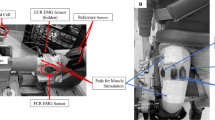Summary
Direct muscular contractions by an electrical stimulation (Tib. ant., Gastroc., Biceps femoris, Rectus femoris) in an unanaesthetized rabbit produce reactions or influence the activity in the muscles of the contralateral side and the forelimbs, following a precise pattern which seems to be similar to that of locomotion. A slight anaesthesia can abolish this reaction, and only a stretch reflex of the antagonistic muscle persists. The stretch-reflex itself is without influence upon the coordinative pattern. We assume that this coordinative pattern orginates from the Golgitendon-organs because this coordination cannot be demonstrated:
-
1.
after severance of muscle nerve of the stimulated muscle,
-
2.
after injection of Novocain in muscle districts near the tendon,
-
3.
after cutting the tendon so that no tension can be developed,
-
4.
after deafferentation so that an antidromic effect is excluded.
We assume that the role of Golgi-tendon-organs of one muscle is not only an inhibition of the muscle himself (see Granit 1950) but a very important factor of coordination in locomotion. So the contraction of one muscle can be the source of inhibition and excitation, mediating by a system of interneurons, which can be influenced centrally. It is interesting to note that we found a similar behaviour in normal human beings.
Similar content being viewed by others
Literatur
Cooper, S., and R. C. Creed: Reflex effects of active muscular contraction. J. Physiol. (Lond.) 62, 273–279 (1927).
Cooper, S., and R. C. Creed: More reflex effects of active muscular contraction. J. Physiol. (Lond.) 64, 199–214 (1927).
Creed, R. S., D. Denny-Brown, J. C. Eccles, E. G. T. Liddell and C. S. Sherrington: Reflex activity of the spinal cord. London, Oxford 1932.
Eccles, R. M., and A. Lundberg: Supraspinal control of interneurones mediating spinal reflexes. J. Physiol. (Lond.) 147, 565–584 (1959).
Gernandt, B. E., and D. Megirian: Ascending propriospinal mechanismus. J. Neurophysiol. 24, 364–376 (1961).
Gernandt, B. E., and M. Shimamura: Mechanismus of interlimb reflexes in cat. J. Neurophysiol. 24, 665–676 (1961).
Granit, R.: Reflex selfregulation of the muscle contraction and autogenetic inhibition. J. Neurophysiol. 13, 351–372 (1950).
Granit, R.: Reflexes to stretch, and contraction of antagonists around ankle joint. J. Neurophysiol. 15, 269–279 (1952).
Gray, J., and H. W. Lissmann: Further observations on the effect of deafferentation on the locomotory activity of amphibian limbs. J. exp. Biol. 23, 121–132 (1946).
Gray, J., and H. W. Lissmann: The coordination of limb movements in the amphibia. J. exp. Biol. 23, 133–142 (1946).
Herterich, E., und H.-J. Hufschmidt: Die Innervation der menschlichen Stammmuskulatur, Programmierung und proprioceptive Reflexe. Pflügers Arch. ges. Physiol. (in Vorbereitung) (1962).
Hoffmann, P.: Über die Beziehungen der Sehnenreflexe zur willkürlichen Bewegung und zum Tonus. Z. Biol. 68, 351–370 (1918).
Hufschmidt, H.-J.: Über den Spannungsreflex beim Menschen. Z. Biol. 111, 75–80 (1959).
Hufschmidt, H.-J.: Über die reflektorische Grundlage des Parkinsontremors. Dtsch. Z. Nervenheilk. 179, 298–308 (1959).
Hufschmidt, H.-J.: Mono- und polysynaptische Reflexe bei Nervenreizung am Menschen. Pflügers Arch. ges. Physiol. 272, 297–306 (1961).
Hufschmidt, H.-J.: Bausteine motorischer Regelung. Schweiz. Arch. Neurol. Psychiat. 87, 260–280 (1961).
Job, C.: Über autogene Inhibition und Reflexumkehr bei spinalisierten und decerebrierten Katzen. Pflügers Arch. ges. Physiol. 256, 406–418 (1953).
Lloyd, D. P. C.: The spinal mechanism of the pyramidal system in cats. J. Neurophysiol. 4, 525–546 (1941).
Lloyd, D. P. C.: Mediation of descending long spinal reflex activity. J. Neurophysiol. 5, 435–458 (1942).
Lloyd, D. P. C., and A. K. McIntyre: Analysis of forelimb-hindlimb reflex activity in acutely decapitated cats. J. Neurophysiol. 11, 455–470 (1948).
Magnus, R.: Körperstellung. Berlin: Springer 1924.
Morson, St., and G. Phillips: Contralateral effects from tension receptors in skeletal muscle. J. Physiol. (Lond.) 88, 199–212 (1936).
Pi Suñer, J., and J.F. Fulton: The influence of the proprioceptive nerves of the hind limbs upon the posture of the fore limbs in decerebrated cats. Amer. J. Physiol. 83, 548–553 (1927).
Rademaker, G. G. J.: Das Stehen. Berlin: Springer 1931.
Sherrington, C. S.: Flexion-reflex of the limb, crossed extension-reflex, and reflex stepping and standing. J. Physiol. (Lond.) 40, 28–121 (1910).
Author information
Authors and Affiliations
Additional information
Mit 6 Textabbildungen
Mit dankenswerter Unterstützung der Deutschen Forschungsgemeinschaft.
Rights and permissions
About this article
Cite this article
Cruz, I., Hufschmidt, H.J. Golgi-Sehnenorgane und spinale Koordination der Motorik beim Kaninchen. Pflügers Archiv 275, 121–133 (1962). https://doi.org/10.1007/BF00363134
Received:
Issue Date:
DOI: https://doi.org/10.1007/BF00363134




